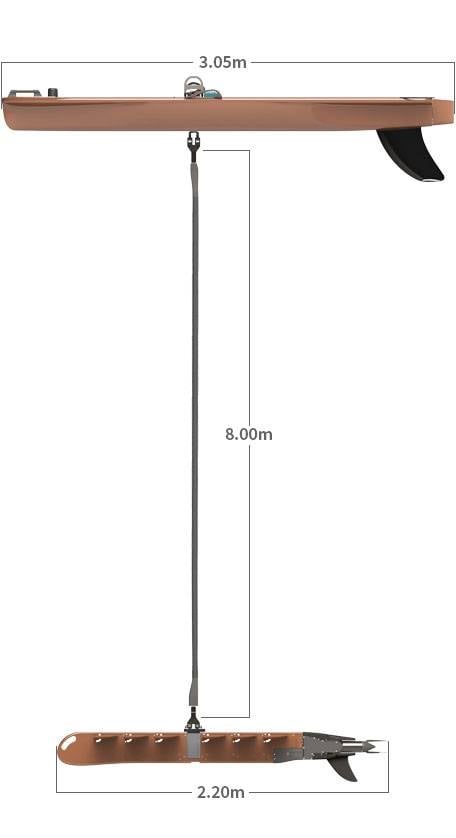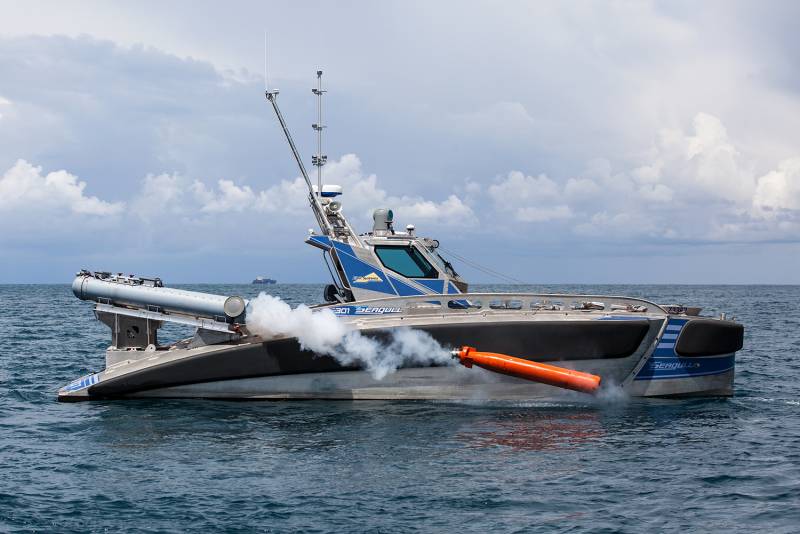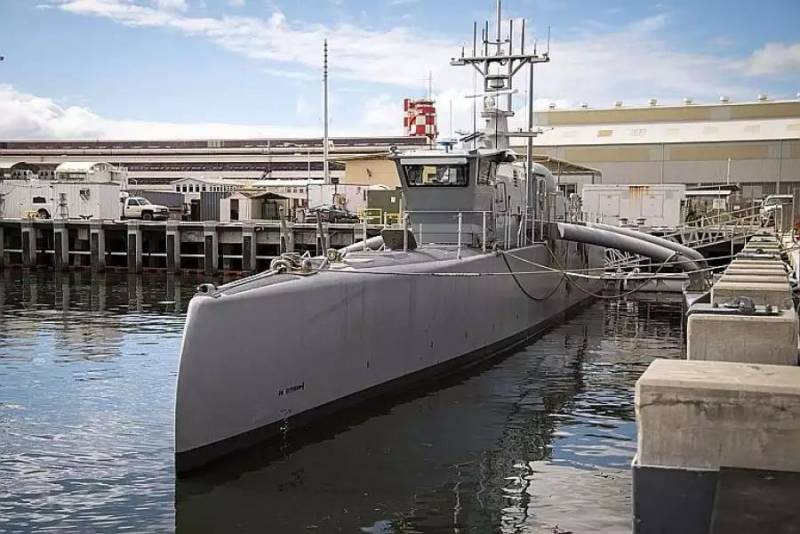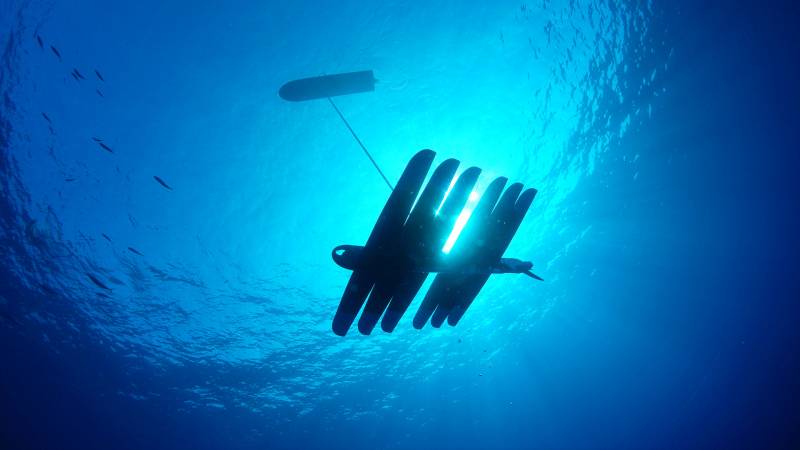US Unmanned Defense Systems
"Submarine chaser"
The most famous and interesting representative of the UAV class for unmanned aerial vehicles is the Sea Hunter unmanned boat, also known as MDUSW (Medium Displacement Unmanned Surface Vehicle). It was created as a multi-purpose platform that can work without a crew and carry various weapon or equipment. First of all, such a boat is necessary for patrolling water areas.
Sea Hunter has a length of 40 m and a displacement of 145 t. The boat is built according to the trimaran scheme with two outriggers. There are two diesel engines that accelerate the ship to 27 units and provide the operation of generators. Cruising range declared at 10 thousand nautical miles. Autonomy - at least 30 days, depending on the task.
The project uses a modular architecture with the ability to install a variety of equipment. One of its options involves the installation of sonar stations to monitor the underwater environment. With such equipment, MDUSW can search for submarines or sea mines. High autonomy allows the boat to stay in a given area for a long time and wait for the appearance of a submarine. Next, the target data is transmitted to the operator, after which other components of the PLO are involved in the work.
According to open data, the Sea Hunter unmanned boat from 2016 is being tested. The operation of all systems is tested in different conditions. In particular, the prototype made several long journeys across the Pacific Ocean. Probably the target equipment is being tested, but the U.S. Navy and DARPA do not disclose such details.
It is expected that in the future a fleet of MDUSW boats or similar products will be built for the navy. They will be able to work independently and in groups, performing patrols of certain areas, including remote from naval bases. A group of Sea Hunter boats will allow you to monitor the situation and identify various targets without involving surface ships or patrol Aviation. With their help, it is proposed to simplify deployment in the right areas, reduce the cost of such operations, as well as increase the efficiency of the PLO and other components fleet.
All these benefits can only be obtained in the distant future. As far as we know, the only built MDUSW / Sea Hunter is still being tested. The timing of the launch of serial construction and the achievement of initial operational readiness remains unknown.
"The rider on the wave"
In 2016, the US Navy commissioned Liquid Robotics to develop a military version of its Wave Glider drone. This product is a multi-purpose crewless platform for installing various equipment. Previously, scientific and research configurations were proposed, and under the 2016 contract, a military version was developed.
Wave Rider is a composite system of two components connected by a cable for towing, as well as the transfer of energy and data. A flat vessel with solar panels and communication equipment remains on the surface of the water. The second component is a tethered submarine with a set of side planes, carrying the necessary instruments and sensors. The surface element of the complex is only 3 m long, the underwater element is 2,2 m. They are connected by a cable up to 15 m long.
The drone has 7 cargo compartments with a total volume of 93 l for mounting the necessary equipment. Solar panels provide up to 20 watts of power. There is a battery to power systems in the absence of lighting. The autonomy of the device depends on the mission and conditions and can reach 1 of the year.
The Wave Rider product does not have its own propulsion system. The movement is due to the energy of the waves. The wave raises and lowers the surface element of the complex, which pulls the underwater. The underwater controls the position of its horizontal rudders and thereby is held on the desired trajectory. The course control is performed by standard rudders. Without a mover, the device develops speed up to the 1-1,3 node.

Product Diagram Wave Rider. Figure Liquid Robotics / liquid-robotics.com
The Wave Rider variant for the US Navy is supposed to carry sonar equipment to search for underwater objects. Such a device will be able to search for mines or enemy submarines. The highest autonomy and limited cost will allow the deployment of large fleets drones and organize long-term patrols of a given area.
To date, the military version of the Wave Rider has managed to enter the test. Earlier it was reported about the launch of experimental military operation of such equipment at several naval bases. In addition, the apparatus was involved several times in various exercises. In the foreseeable future, full-scale production and deployment is expected.
Imported "Seagull"
In the context of unmanned aerial vehicles, the US Navy and NATO fleets are also interested in foreign developments. So, last year, the Seagull multipurpose unmanned boat from the Israeli company Elbit Systems was attracted to the next exercises. This product successfully worked in conjunction with surface ships of the Navy of several countries.
Seagull is a 12-meter boat with a rigid hull, equipped with all the necessary instruments and capable of carrying a payload of up to 2,5 t. Remote control and autonomous controls are provided. The cruising range of the boat reaches 1900 nautical miles, and satellite communications provide work at any distance from the operator. Fuel autonomy - up to 4 days.
An Israeli boat is capable of carrying equipment for various purposes, up to combat modules with small arms or missile weapons. A few years ago, Elbit Systems introduced a specialized anti-submarine version of the boat. In this version, the ship carries several ASGs with different capabilities, and is also armed with a pair of torpedoes. The PLO boat is able to search for underwater targets, transmit data about them to different consumers, and also independently carry out an attack.

The Seagull boat in anti-submarine configuration performs torpedo fire. Photo Elbit Systems / elbitsystems.com
The Seagull boat in different versions has already passed the tests. The PLO variant has been demonstrated for several years, and last year even participated in NATO maneuvers. This model receives high marks and can be used by some countries of the North Atlantic Alliance, including USA.
General trends
Submarines of a potential enemy with strategic missiles on board pose a special danger, and it is necessary to combat it by organizing anti-submarine defense. New technologies can simplify the development and deployment of PLO by eliminating the most complex components and optimizing costs.
Unlike surface ships or hunter submarines, crewless systems can be produced in large quantities and within a reasonable time. Due to this, they can be quickly deployed in all dangerous directions in order to timely detect enemy SSBNs. Crewless systems can continue to operate for a long time and are minimally dependent on the person, which contributes to high performance.
The Pentagon understands all this and pays necessary attention to new projects. A number of promising systems based on unmanned platforms are being developed and tested, and some of them are approaching adoption. The question of finding submarines of a likely enemy in the oceans is becoming relevant again - and the US Navy is taking the necessary measures.


Information